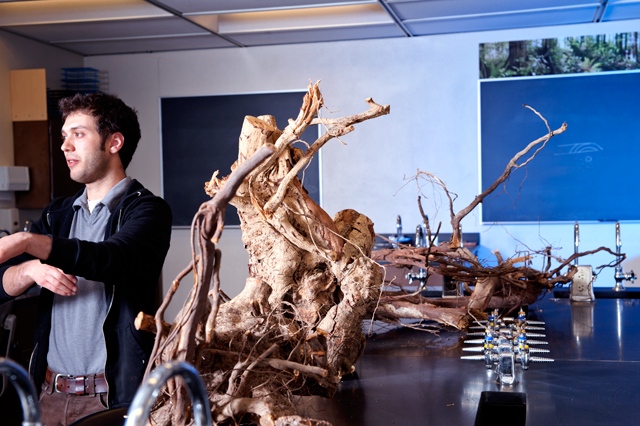
According to Namm, a student in Humboldt State’s Forestry graduate program, the project has several implications for land managers. First, by better grasping what comprises a tanoak’s root system, it becomes easier to estimate the entire biomass of a given area—and to estimate the amount of carbon sequestered therein. Second, with a more accurate description of the species’ above ground and below ground characteristics, it becomes possible for land managers to potentially plan for replacement species should sudden oak death disease takes its toll on a given tanoak population.
Mathematical models exist for estimating a tree’s above-ground biomass, but little research exists for the underground portion of the tree. Namm’s goal was to create a model that would work for the roots. “We wanted to be able to take a quick measurement—in this case [a tree’s] diameter at breast height (DBH)—and easily estimate the root’s biomass,” says Namm, who earned his undergraduate degree in Environmental Studies at UC Santa Cruz. Current models, developed in the early 1980s, can determine a tree’s above biomass using standard measurements like a tree’s basal area and DBH.
The results of Namm’s research are encouraging. He’s been able to find a connection between a tanoak’s DBH and root biomass. He’s also been able to describe, in scientific terms, and structure and intricacy of a tanoaks root system.
A Big Dig
To get to the roots of the tanoaks on the L.W. Schatz Demonstration Tree Farm, Namm hired an excavator to dig meter-deep trenches around the 12 sample trees used in the project. The trees were then toppled and Namm and research volunteers painstakingly cleaned the roots. Once stripped of the dirt, the roots were moved to a lab in HSU’s Natural Resources Building and the months-long work of classifying the roots’ structure began.
For starters, Namm devised a way to make sense of the gnarled ball of woody tubers and fine root tips. With his trusty stainless-steel digital caliper, Namm meticulously cataloged the tanoak root systems, creating an 8-part root morphology model that could accurately catalog the main, fork and branch sections of the roots. Namm looked at root length, diameter, rate at which the roots taper, weight, location in the root system and distance from the tree. In taking these measurements, some 5,000 times, Namm was able to confirm that a relationship did exist between above ground measurements and the biomass of the root system. He could also estimate the amount of carbon sequestered therein improving upon a commonly accepted research model that assumes 50 percent of wood’s dry weight is carbon.
Initially Namm expected to find more carbon closer to the tree, where the roots are thickest, but the opposite appeared to be true: the finer roots further from the tree appear to contain more carbon. “Not only that, we also surprised to learn root density was consistent throughout instead of being higher in the thicker parts of the root close to the tree.”
Undergrads Restore Study Site
After the samples were removed from the tree farm, undergraduate students from Professor John Pascal Berrill’s forestry courses moved in to conduct a complete ecological restoration. The students planted Douglass firs, huckleberries and salal shrubs, ensuring a health understory to compliment the trees. “This kind of collaboration is exactly the kind of research that Humboldt State does well,” says Berrill.
After earning his degree this May, Namm looks forward to getting out side. “I’m definitely interested in field research after being the lab for so many months,” he says. Namm hopes to one day earn his doctorate, but says first he’d like to explore more about forestry to make sure he lands in a program that piques his interest.